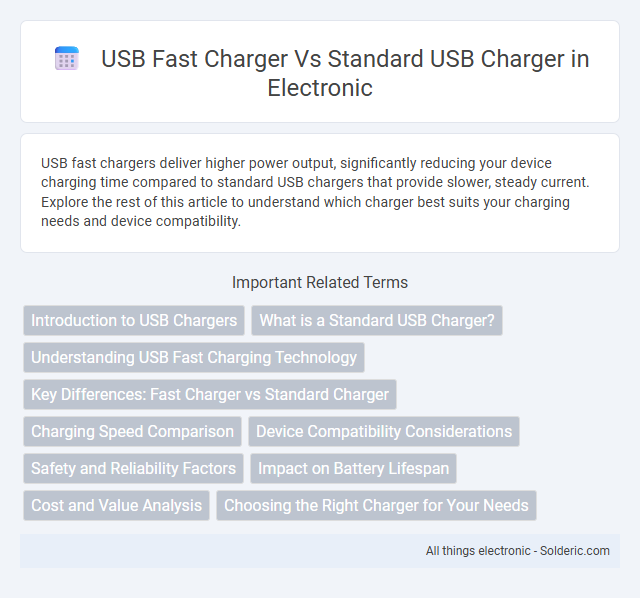USB fast chargers deliver higher power output, significantly reducing your device charging time compared to standard USB chargers that provide slower, steady current. Explore the rest of this article to understand which charger best suits your charging needs and device compatibility.
Comparison Table
| Feature | USB Fast Charger | Standard USB Charger |
|---|---|---|
| Charging Speed | Up to 4x faster, supports Quick Charge, Power Delivery | Standard 5W to 12W charging speed |
| Power Output | 18W to 100W, varies by model | Typically 5W to 12W |
| Technology | Supports USB Power Delivery (PD), Qualcomm Quick Charge | Basic USB charging technology |
| Compatibility | Compatible with devices supporting fast charge protocols | Compatible with all USB-powered devices |
| Heat Generation | May generate more heat due to higher power output | Less heat generated |
| Cost | Higher cost, usually $15 to $50 | Lower cost, usually $5 to $15 |
| Use Case | Ideal for rapid charging smartphones, tablets, laptops | Best for overnight or slow charging |
Introduction to USB Chargers
USB fast chargers deliver higher power output, significantly reducing your device's charging time compared to standard USB chargers that supply lower wattage. Fast chargers support technologies like Qualcomm Quick Charge or USB Power Delivery, enabling compatibility with a wide range of smartphones, tablets, and laptops. Choosing the right charger ensures optimized performance and longevity for your devices, keeping them powered efficiently.
What is a Standard USB Charger?
A Standard USB charger typically provides 5 volts at 1 to 2.4 amps, delivering up to 12 watts of power suitable for basic device charging. It uses the USB 2.0 or USB 3.0 specifications and supports consistent current output for smartphones, tablets, and other small electronics. Standard chargers lack adaptive voltage technology found in USB fast chargers, resulting in slower charging speeds.
Understanding USB Fast Charging Technology
USB fast charging technology significantly reduces device charging time by delivering higher power output, typically up to 27W or more, compared to standard USB chargers that provide around 5W. Fast chargers utilize protocols like Qualcomm Quick Charge, USB Power Delivery (USB-PD), and proprietary technologies to dynamically adjust voltage and current based on device compatibility. This smart adaptation minimizes heat generation and enhances battery lifespan while ensuring rapid, efficient energy transfer.
Key Differences: Fast Charger vs Standard Charger
Fast chargers deliver higher power output, typically ranging from 18W to 65W or more, enabling devices to charge significantly faster compared to standard USB chargers that usually provide 5W to 12W. Fast chargers utilize advanced technologies like USB Power Delivery (PD) or Qualcomm Quick Charge, which dynamically adjust voltage and current for optimal charging efficiency, while standard chargers deliver a fixed, lower power output. Compatibility with device firmware and battery management systems also distinguishes fast chargers, ensuring safe and rapid charging without overheating or battery degradation.
Charging Speed Comparison
USB fast chargers deliver significantly higher amperage and voltage levels compared to standard USB chargers, resulting in markedly reduced charging times for compatible devices. Fast chargers utilize technologies like Qualcomm Quick Charge or USB Power Delivery, enabling up to 4 times faster charging speeds than traditional 5W standard chargers. Your device's compatibility with fast charging protocols directly impacts the efficiency and speed at which it replenishes battery life.
Device Compatibility Considerations
USB fast chargers require devices that support fast charging protocols like Qualcomm Quick Charge or USB Power Delivery to achieve optimal performance, whereas standard USB chargers provide a consistent, slower charge compatible with virtually all USB devices. Using a fast charger with an incompatible device results in charging at standard speeds, ensuring safety without damaging the battery. Compatibility considerations include checking device specifications and supported charging standards to maximize charging efficiency and maintain battery health.
Safety and Reliability Factors
USB fast chargers employ advanced circuitry with built-in temperature control and overcurrent protection, enhancing safety compared to standard USB chargers. Standard USB chargers often have simpler designs that may lack these protective features, increasing the risk of overheating or electrical faults. Ensuring you use a certified fast charger from reputable brands improves reliability and safeguards your device during rapid charging sessions.
Impact on Battery Lifespan
USB fast chargers deliver higher voltage and current compared to standard USB chargers, leading to quicker battery charging but potentially generating more heat. Excessive heat and rapid charging cycles can accelerate battery wear, reducing overall lifespan by stressing the battery's chemical components. To preserve your battery's health, it's advisable to use fast charging only when necessary and avoid excessive fast charging sessions.
Cost and Value Analysis
USB fast chargers typically cost more than standard USB chargers due to advanced technology that delivers higher power output, reducing device charging time significantly. While the upfront investment is higher, the value comes from saving time and improving device convenience, especially for power-hungry gadgets like smartphones and tablets. Consider Your charging needs and frequency to determine if the faster charging speed justifies the additional cost.
Choosing the Right Charger for Your Needs
Selecting between a USB fast charger and a standard USB charger depends on your device compatibility and charging speed requirements. USB fast chargers provide higher wattage output, significantly reducing charging time for devices that support Quick Charge or Power Delivery protocols. For everyday use with older or less power-demanding devices, a standard USB charger delivers sufficient power without unnecessary energy consumption.
USB fast charger vs Standard USB charger Infographic

 solderic.com
solderic.com